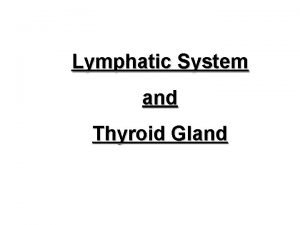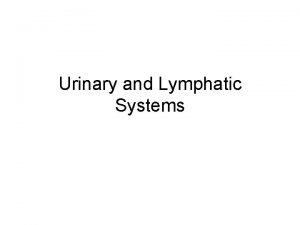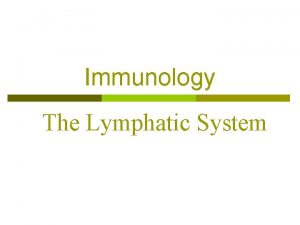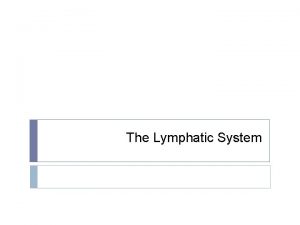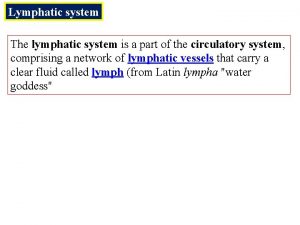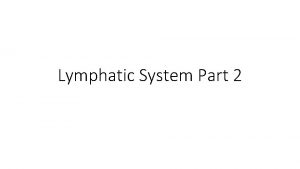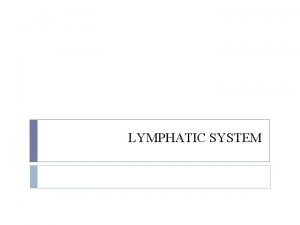Lymphatic system The lymphatic system is part of










- Slides: 10

Lymphatic system The lymphatic system is part of the circulatory system, comprising a network of vessels called lymphatic vessels that carry a clear fluid called lymph.

Functions § The lymphatic system has multiple interrelated functions § It is responsible for the removal of interstitial fluid from tissues § It absorbs and transports fatty acids and fats from the digestive system § It transports white blood cells to and from the lymph nodes § The lymph transports antigen-presenting cells (APCs), , to the lymph nodes where an immune response is stimulated.

Lymph § It is a clear, watery, light yellow fluid. § It is similar in composition to plasma and interstitial fluid with low protein content. § It contains all kinds of leucocytes.

Lymph Nodes § Range from 1– 25 mm diameter § • Function as a filter for the lymph fluid § • 600 bean-shaped lymph nodes scattered throughout the body § – Large numbers in the cervical, axillary, and § inguinal regions

Function of Lymph Nodes § § § Filtration and purification of lymph. Site for lymphocyte proliferation. Site for antibody production

Tonsils are collections of lymphoid tissue facing into the aerodigestive tract

Function of Tonsil § The tonsils participate in systemic immune defense. Like other organs of the lymphatic system, the tonsils act as part of the immune system to help protect against infection. In particular, they are believed to be involved in helping fight off pharyngeal and upper respiratory tract infections (in other words they help to control throat infection) The tonsil is a lymphoid tissue that helps fight against ingested pathogens they protect you from getting diseases

The Spleen § It is the largest lymphoid organ. § it is located in the upper left Quadrant of the abdominal cavity, below the diaphragm. § Functions of the Spleen § 1. Removal of abnormal blood cells and other blood components § § 2. Storage of iron recycled from red blood Cells § 3. Initiation of immune responses by B cells § and T cells: in response to antigens in circulating blood

Thymus § The thymus is a specialized organ of the immune system § Location: lies behind the upper sternum and extends upwards into the root of the neck. § Structure: § Consists of two lobes Joined by areolar tissue. § Each lobe consists of cortex and medulla. § Weight: about 10 gm, reaching 40 gm at puberty.

Functions § Maturation of the immature lymphocytes in 2 -3 days by thymosin hormone. § Proliferation of lymphocytes
 Is thyroid a lymphatic organ
Is thyroid a lymphatic organ Lympathic
Lympathic Lymphatic and urinary system
Lymphatic and urinary system Lymphatic drainage of lower limb pdf
Lymphatic drainage of lower limb pdf What are the function of lymphatic system
What are the function of lymphatic system Chapter 12 the lymphatic system and body defenses
Chapter 12 the lymphatic system and body defenses Functions of the lymphatic system
Functions of the lymphatic system Cardiovascular/lymphatic system it's totally tubular
Cardiovascular/lymphatic system it's totally tubular Largest lymphoid organ
Largest lymphoid organ Lymph function
Lymph function Lymphatic system is composed of
Lymphatic system is composed of
